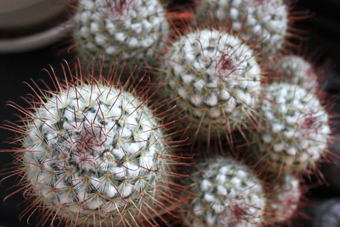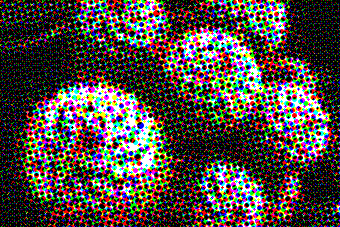LBitmap::ColorHalfTone
Summary
Creates an enlarged halftone screen for each image channel.
Syntax
#include "ltwrappr.h"
L_INT LBitmap::ColorHalfTone(uMaxRad, nCyanAngle, nMagentaAngle, nYellowAngle, nBlackAngle, uFlags = 0)
Parameters
L_UINT uMaxRad
Maximum dot (i.e. circle) size, in pixels. This value should not be less than 5.
L_INT nCyanAngle
Cyan screen angle in hundredths of degrees (+/-). A positive value will rotate the screen clockwise, while a negative value will rotate the screen counter-clockwise. Valid values are from -36000 to +36000.
L_INT nMagentaAngle
Magenta screen angle in hundredths of degrees (+/-). A positive value will rotate the screen clockwise, while a negative value will rotate the screen counter-clockwise. Valid values are from -36000 to +36000.
L_INT nYellowAngle
Yellow screen angle in hundredths of degrees (+/-). A positive value will rotate the screen clockwise, while a negative value will rotate the screen counter-clockwise. Valid values are from -36000 to +36000.
L_INT nBlackAngle
Black screen angle in hundredths of degrees (+/-). A positive value will rotate the screen clockwise, while a negative value will rotate the screen counter-clockwise. Valid values are from -36000 to +36000.
L_UINT32 uFlags
Reserved for future use. Must be 0.
Returns
| Value | Meaning |
|---|---|
| SUCCESS | The function was successful. |
| < 1 | An error occurred. Refer to Return Codes. |
Comments
The filter divides the image into rectangles and replaces each rectangle with circles. Each channel has a separate grid of circles, and has its own angle setting. The size of each circle is proportional to the brightness of the rectangle that it is replacing.
This filter is named after the colored print process of color halftoning, where individual separations are made for each color: Cyan, Magenta, Yellow, and Black. The four separations are combined to make the final print. To prevent moir patterns, each separation uses a different screen angle when they are combined. In the true print process the circles are not large enough to be seen without magnification.
To update a status bar or detect a user interrupt during execution of this function, refer to LBase::EnableStatusCallback.
This function supports 12 and 16-bit grayscale and 48 and 64-bit color images. Support for 12 and 16-bit grayscale and 48 and 64-bit color images is available only in the Document/Medical toolkits.
If the bitmap has a region, this function works only on the region. If the bitmap does not have a region, this function works on the entire bitmap.
This function does not support signed data images. It returns the error code ERROR_SIGNED_DATA_NOT_SUPPORTED if a signed data image is passed to this function.
This function does not support 32-bit grayscale images. It returns the error code ERROR_GRAY32_UNSUPPORTED if a 32-bit grayscale image is passed to this function.
Color Halftone Function - Before

Color Halftone Function - After

View additional platform support for this Color Halftone function.
Required DLLs and Libraries
- LTIMGEFX
- For a listing of the exact DLLs and Libraries needed, based on the toolkit version, refer to Files To Be Included With Your Application.
Platforms
Win32, x64.
See Also
Functions
- LBitmapSettings::DefaultDithering
- LBitmapBase::GrayScale
- LBitmap::GrayScaleExt
- LBitmap::AutoColorLevel
- LBitmap::ColorLevel
- LBitmap::Correlation
- LBitmap::GrayScaleToDuotone
- LBitmap::GrayScaleToMultitone
- LBitmap::SelectiveColor
- LBitmap::Skeleton
- LBitmap::HalfTone
- LBitmap::ColorSeparate
- LBitmap::ColorMerge
- LBitmap::Desaturate
- LBitmap::HalfTonePattern
- LBitmap::ConvertToColoredGray
- LBitmap::ColorizeGray
- LBitmap::ShiftData
- LBitmap::SelectData
- LBitmap::GetMinMaxBits
- LBitmap::GetMinMaxVal
- LBitmap::GetHistogram
- LBitmapBase::IsGrayScale
- LBitmap::WindowLevel
- LBitmap::WindowLevelExt
- LBitmap::WindowLevelFillLUT
- LBitmap::WindowLevelFillLUTExt
- LBitmap::Skeleton2
Topics
- Raster Image Functions: Doing Color Expansion or Reduction
- Correcting Colors
- Color Halftones and Halftone Images
- Raster Image Functions: Functions Where the Region Preempts the Bitmap
- Raster Image Functions: Working with Color Halftones, Halftones, and Grayscale Images
- Raster Image Functions: Correcting Colors
Example
L_INT LBitmap__ColorHalfToneExample(){L_INT nRet;LBitmap LeadBitmap;nRet =LeadBitmap.Load(MAKE_IMAGE_PATH(TEXT("IMAGE1.CMP")), 0,ORDER_BGR);if(nRet !=SUCCESS)return nRet;nRet =LeadBitmap.ColorHalfTone(15, 10800, 16200, 9000,4500);if(nRet !=SUCCESS)return nRet;return SUCCESS;}
© 1991-2025 Apryse Sofware Corp. All Rights Reserved.
